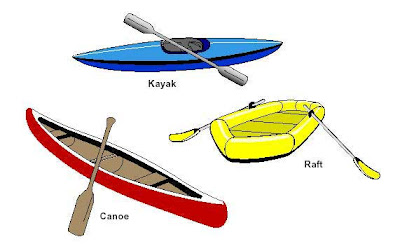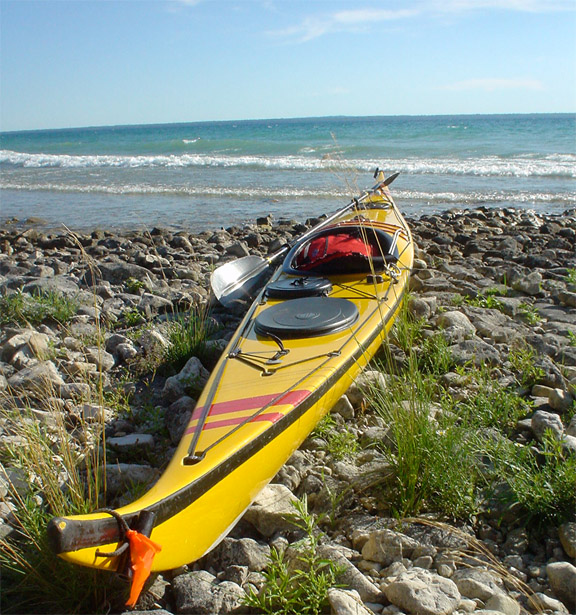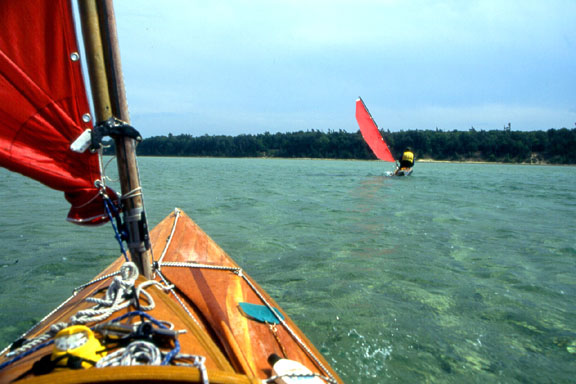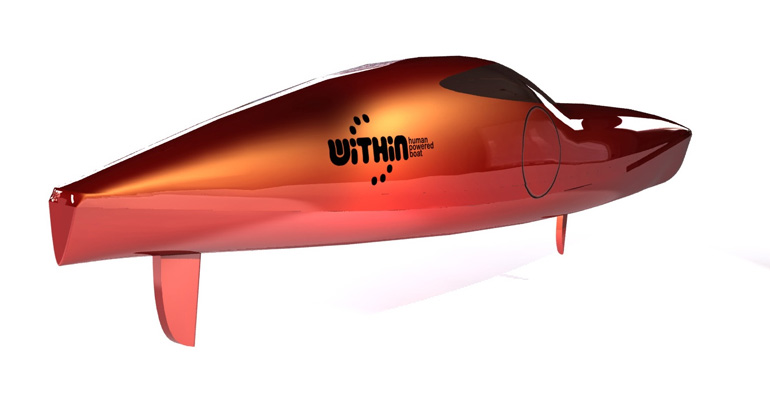I’ve long wondered about the Demise of the Canoe in comparison to the Triumph of the Kayak. I note that with today’s dominance of the kayak format in all types of paddling that we don’t actually seem to have more people out on the water.
That’s because kayaks aren’t good for some of the more popular kinds of Great Lakes waterway. Doh! Yet they’re what people own now. Also, they weigh a lot more — two hulls rather than one. Also you sit down low in them so you can’t move around, or see anything, or get in/out easily. So they hang in garages.
Yet today’s market seems to be 90% kayak-type boats. Canoes haven’t disappeared but they really just don’t get much attention.
Here are some rambling ruminations on the subject…
What are kayaks good for? Waves. That’s all. Their double/upper hull (deck) sheds splashes. Their lowness gives stability when tossed about. So they’re great for big, windy, wavy lakes/seas (sea kayak). And for whitewater. –Both are conditions that the bulk of Great Lakes paddlers don’t actually encounter. Yes, a fair number do. For sure, people who live near whitewater will appreciate boats made for it. But that’s not Michigan. Those who actually go out in “conditions” and who actually playboat in foaming holes are a minority of boat owners in the Midwest. But, of course, they are wonderful boat uses. More power to ’em! Waves of all kinds are there to be loved. If you really do get the skills for big water and waves’n’wind paddling, then a kayak is great. Getting wet and doing semi-immersed paddling is marvelous. …But the general state of paddling is a bit like if Downhill Mtbikes were what we mostly saw in people’s garages…and there were no mountains around. We’d know why they were hanging there more than being used.
A kayak is typically rotomolded. With the double hull/deck it weighs 40 lbs. But few would call a tandem canoe that weighed 80 lbs “sporty.” Yet solo kayaks at 40 lbs and in all sorts of rainbow plastics rule the roost. When folks first get a an allround kayak they’re game to fling it up onto roofracks, but really you need two to move them around. Their ungainliness soon is apparent.
Now, I do give to kayak props for a common enjoyment factor and situation. Because you sit lower the hull can be narrower and speedy without giving up stability. Because you’re lower the hull can also be shorter and still keep some speed, due to the narrowness. For a canoe to be on par it needs to be a C1 — a solo boat. You sit high in a canoe usually (on our Midwest rivers — though kneeling is a mode, too). To get stability your hull is a bit wider and longer than a solo kayak. Speed is about the same. …But the kayak is often turnier for our frequently twisty streams. So on our dozens of Up North twisty, windy little rivers you’ll see liveries renting sit-on-top kayaks to nearly everyone. They can easily zip around the corners and never “take on water.”
Another angle that has perhaps stymied canoe love is the “negative space” aspect of them. They’re a big cup. With a brim just waiting to scoop up water. …If only psychologically. The instinct is to cover that opening. …Even though covering it stops you from: *moving around freely in the boat; *loading stuff easily; *keeping the boat light.
Then we have the frequency of tandems in canoe-land. 95% of canoes are tandems. While only 5% of kayaks are. …Odd, that.
Tandem canoes do have an awkwardness for one of their most common uses: that same twisty river. It’s an art to get around the corners nicely. Thus most paddlers bash sideways into the logjams at the exits of the corners. …Curing them of their willingness to paddle a tandem canoe. Solo canoes and kayaks are far more maneuverable. Kayaks also have another feature maybe 80% of the time. While about only 1% of canoes have it. …A rudder. A rudder would help any canoe to much more easily get around corners and control direction and compensate for mismatched paddling (skill/strength).
Canoes do get blown around more. People don’t often go onto big water on purpose in “conditions,” but when they do a kayak gives them more (false) comfort. If they’d be nervous in a canoe they should probably also not go out in a kayak. Kayaks, of course, have been big-lake drowners ever since they became more popular. I suppose canoes have done the deed, too, though. But kayaks do have an image of “bring it on!” which the untrained die from by the score.
Anyway, the higher seating of canoes gives great views of underwater world — including obstacles. It gives great paddling ergonomics. It’s easy to get in and out of. You can easily stand in most canoes — with practice — to pole or paddle (or to get in and out or maneuver). And you can easily haul gear and luggage and get at it. And a single paddle lets you paddle without getting tired. And it’s very common to be able to happily fit two or more people into a canoe.
So why have kayaks won out so hugely? I suppose it’s mostly because they have the “big air dude” rep of “more fun” and “splashing.” And I’m guessing that they have a better profit margin for mass production. ? …But kayaks do have those mentioned occasions of betterness.
There’s been one major attempt to blend the two types of boat … by Verlen Kruger. Several boats were and are built to his specs (by two major companies in the past and now by a custom shop). They’re canoe-kayaks. …Partially decked canoes with lower, finer ends that don’t get blown around, and often with seats that adjust vertically — higher when you want to canoe; lower when it’s wavy and/or you want to kayak. …Often sporting a rudder. With a big wide cockpit for easily moving around and stowing stuff. They have hundreds of loyal fans. But they’re a micro-niche with a reputation for extreme endurance and only high-end models now available. Nobody does anything to promote them more broadly.
Lastly, there’s a “manufacturing versus appropriateness” conflict. Human power vehicles of any type need to be light and “crisp” to give performance in normal conditions. We’re dealing with a 1/4 hp engine, after all. Water is, furthermore, much more unforgiving than air. Even carrying things around has a firm limit, normally. The body grumbles when asked to haul stuff with the arms/hands that weighs more than 40 lbs. Basically, for a human to enjoy carrying and paddling a boat it needs to be light and well-made. This conflicts with the needs of manufacturing, which gives best profit margins with crude and heavy. Crude and heavy works for “bash boating” in swift currents and for booze-oriented “floating” where paddlers don’t even really paddle much.
This isn’t exactly an issue between canoes and kayaks: both benefit from better construction.
Now, manufacturing has become groovier in recent decades. You can get a fairly pleasant kayak with lots of features for cheap money at a Big Box store. They’re cheap to make. They’re easy to turn. And most can tolerate getting in and out of them. So what if they’re overkill for the kind of paddling most people do. They haven’t been able to figure out how to make a comparable canoe so cheaply.
Today’s rotomolding not only pleases the general calm river paddler, it also delivers tricky shapes that are nice enough to please a modest seakayaker or even elite whitewater paddler.
But those who live near moderate waters who have light, crisp canoes that let them sit up higher and apply easy power have an easy time with a wide variety of paddling and with boat-carrying and can often can skip the need for river shuttles since they can just paddle back upstream. Those who paddle cheap, crude kayaks never paddle very far upstream. They’re glued to the shuttle. (And often hire both boat and shuttle. And a big part of this biggest niche is the “drinking floater.”)
Then, too, light, fine kayaks work best for those who are really paddling in wind’n’waves and lugging their boats around often — and there are several niches of top craftsmanship that serve the smallish number of kayakers who appreciate those values. But even though there may not be many quality kayaks overall they still probably quadruple the size of the quality canoe market. (Weight and fineness being lesser values for even the elites of the shuttled WW playboat world.)
So there ya have it! …The situation.
(I may well be off on some datapoints. But I think I have the general tendencies sorted out. Feel free to correct me if I don’t!)
Do canoes have a future? They’ve had mini comebacks. But kayaks stay in the driver’s seat despite perhaps only a quarter of the common paddling modes in the Great Lakes being truly suited for them.



